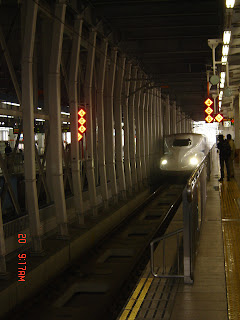Trip to Kyoto

On 20 November, I took a bullet train to Kyoto which goes over 250km/h. Smooth and fast.
I heard that there is a plan to connect Madrid to Portugal by AVE, Spanish bullet train. I wonder if I can take it near future. (I don't want to take a Targo. It was a tiring experience...)
The purpose of this trip is to sit for a Portuguese examination (in level B1) which is run by the Faculty of Literature at the Lisbon University.

I went to this Tempura restaurant with Nuno last summer. This time, a queue was much longer. The chef was very busy with preparing Tempura. Even though there were an incredible long queue, he prepared tempura for all those who lined up till 14:00. It is really a good service.

It is called "Tendon", deep-fried battered eel placed over a bowl of rice and seasoned with a soy-based light-flavoured sauce. There are two regional styles of Tempura: Kansai (Osaka) and Kanto (Tokyo). In the Tokyo style seafood and vegetables are fried in sesami oil which gives a distinct flavour. Tempura is golden yellow. The picture is Tokyo style Tempura.

The man on bicycle is a cook who is delivering a meal to customers such as "Geiko" or "Geisha", traditional Japanese performers who play an instrument and show a traditional dance - the people who do not have time to go out for lunch.

The season for crabs has just started.

Saba-zushi
This fish with a shiny sliver and blue skin is called saba in Japanese. It is called mackerel in English, caballa in Spanish and cavala in Portuguese.
Fish is prepared in fillets, by cutting off the parts which contains bones and marinaded in vinegar which sweeten with sugar. Consequently, smells of raw fish is removed. This type of fish prepared differently from white meat fish like red sea bream or reddish tuna which served completely raw. No horse radish is attached.

This is "Nigiri-zushi", the most well-known type of sushi around the world. Please excuse me if I make any mistakes. From the left, sea bass (suzuki), tuna (akami), amberjack (kanpachi), prawn, squid, octopus, egg and salmon roe (ikura).
Sushi is not served hot as you know but it should not be served cold, either. What I want to say is to be prepared after ordered so that it can be nice in body temperature. When it gets cold, rice sticks together. So, if you want to taste delicious sushi, you should go to a small family-run sushi restaurant like I did.

On the way to have lunch, I luckily encountered "Maiko". They are trained performer who play traditional musical instruments and perform dance called "nihon-buyo". I have not read an English novel called "geisha". Hearing about the images which some foreign tourists told, maiko or geisha were mistakenly known as a misterious prostitute. I believe it was enhanced by fiticious images created by silly novelists. Many of them start their training from the age of 16. They spend a number of years to become a professional performer like the ones in the picture.
Last summer, I and Mr. Vicente met young Maiko trainees at Starbucks. He had a picture with one of them, the prettiest one, I would say. (I am a bit worried if he received any Kanfu kick from his wife later... To defend him, I should say that I was the one who chose her consequently. Because I met her eyes when I asked for photos. Since I met with her eyes, she responded "with me?". I could not say "with all". It's not polite to say so.) By the way, Nuno commented that she was not so friendly apart from being coutesious. Maybe I should explain to you about our culture and etiquette that the Japanese women should have traditionally. They are usually expected to show minimum facial expressions. For those who becomes Maiko in future, it is a must. Until very recently, quiet and less emotional women were admired greatly. They are considered to be more sophisticated in such manner. So, you can not expect Maiko to be lively and talkative. However, they are trained to be very knowledgeable and capable to show true Japanese etiquettes. Next time, I want to go to a traditional "Kaiseki" restaurant with some foreign friends to enjoy Maiko performance. (Unfortunately, Mr. Vicent often resist to dress formally. Last summer, he did not bring anything a bit formal...) I also didn't have enough knowledge as well.

This traditional Japanese house offers green tea and sweet.

When you go inside, you find a typical Japanese room with tatami mat floor, where you must take off your shoes. There are a number of places like this, which are not used for a small cafeteria or restaurant. But you can almost only find them in Kyoto.

On the right, there is a bowl of green tea called "macha". Macha is a high quality tea. Tea leaves are ground into powder. To serve macha, the fine powder is placed into a bowl directly and then hot water is poured over them. Then, it is whisked with a bamboo scoop in a way that you beat eggs or whipped cream to make sweet. In macha, you consume tea in powder directly. It is bitter. So, it is accompanied with some sweet on the right.

This is another traditional Japanese house which is converted into a restaurant. I have been to this restaurant with a Portuguese friend for dinner last summer. We enjoyed the atmosphere of the building and meal.

This time, I went for lunch.
This restaurante served grilled barbecue chicken. In Japanese, it is called "yakitori". I had a bowl of rice topped with different types of barbecued chicken and eggs.
